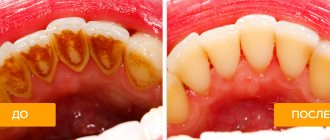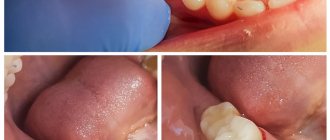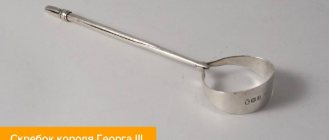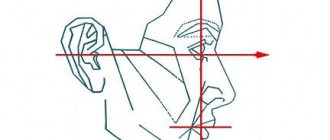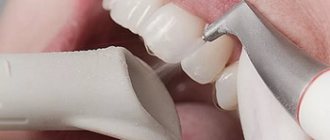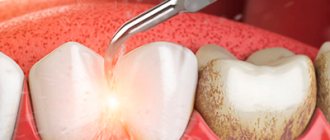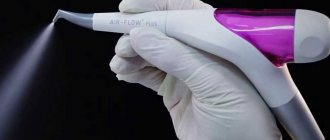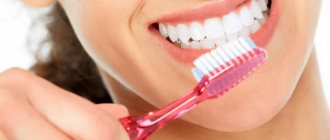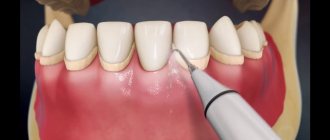An open smile is attractive, but many people are embarrassed to smile back because they are not ready to show teeth that are not too healthy and not very white. Everyone knows about the need to treat caries, but the disease is not the only problem that can ruin the appearance of teeth. The presence of hard mineralized deposits, so-called “tartar,” also leads to serious consequences, in particular, periodontal disease. It is impossible to remove them by simply brushing your teeth at home. Moreover, even detecting tartar on your own is not easy.
Professional teeth cleaning
The removal of mineralized deposits and plaque, carried out by a dentist using modern equipment, instruments and drugs, is called professional teeth cleaning. It is recommended for everyone, without exception, to periodically use the services of specialists, but patients with fixed orthodontic structures - braces, bridges, crowns, veneers, implants - should especially carefully monitor the condition of the oral cavity. Professional cleaning is necessary before teeth whitening.
At home, it will not be possible to remove plaque from your teeth 100%, even if you follow all the rules for cleaning your mouth and using the highest quality products. It usually accumulates between the teeth, in the cervical area, on the back surface, in the subgingival space. Plaque is filled with mineral compounds and becomes denser over time, turning into tartar, which is almost impossible to remove on your own. Treatment of diseases caused by tartar is much more expensive than professional cleaning of still healthy teeth.
When is laser cleaning recommended?
The following changes may be the reason for prescribing the procedure:
- plaque has formed on the teeth, darkening the enamel by several tones;
- bad breath;
- bleeding gums;
- minor inflammation of the gums in the early stages;
- smoking, coffee addiction;
- teeth whitening planned;
- before dental treatment.
As a preventative measure, it is recommended to visit the dentist at least once a year (preferably twice) and regularly perform in-office cleaning.
Contraindications to the procedure
Contraindications to professional teeth cleaning are:
- severe inflammation of the mucous tissues of the oral cavity. After the inflammation has been eliminated, the procedure can be carried out;
- enamel erosion;
- arrhythmia (history);
- high sensitivity of teeth;
- childhood and adolescence;
- epilepsy;
- acute infectious diseases;
- severe form of bronchial asthma;
- diabetes;
- chronic rhinitis or runny nose due to ARVI.
Laser cleaning technology
A laser is a directed, focused, high-energy beam of light. Its effect occurs non-contactly, without exerting pressure on the surface of the teeth. This makes the procedure completely safe and painless, even if the patient has increased tooth sensitivity.
The concentrated light flux kills pathogenic bacteria, completely safe for enamel, “evaporates” the oldest and hardest plaque, removes dead cells and strengthens living mucous tissue, launching its regeneration processes.
This helps prevent inflammatory diseases of the gums and periodontium - gingivitis, stomatitis, periodontitis, and stop the development of caries at the earliest stages.
The laser operates absolutely silently, so patients who are afraid of the sound of the drill do not experience psychological discomfort in the dentist's chair.
Also, after laser cleaning, the effect of lightening the enamel is observed due to the elimination of its contamination and the consequences of drinking coffee or smoking.
Carrying out a professional teeth cleaning procedure
Until relatively recently, enamel was cleaned exclusively mechanically using dental instruments. The duration and traumatic nature of the procedure for teeth could only be justified by the need for cleaning. Today, Novosibirsk dentists have in their hands advanced techniques and modern devices that ensure complete safety of professional cleaning and quality of teeth cleaning.
Manipulations include:
- removal of dense deposits and soft plaque;
- teeth polishing;
- applying a protective layer of fluorine varnish.
Description of the technique
The procedure is usually carried out as follows:
- At the patient's request, local anesthesia can be administered with a spray or gel. This is done solely for the psychological comfort of the person, since there is no need for pain relief.
- The doctor uses a special brush to remove soft plaque.
- The gums are protected with soft pads.
- The tooth surface is treated with a gel containing active oxygen.
- Perform laser cleaning.
- The removed plaque along with the remaining gel is removed with a special dental “vacuum cleaner”.
- Teeth are polished and polished using different attachments.
- The enamel is coated with a fluorine-containing compound that protects and restores it.
After the procedure, no recovery time is required; the patient can almost immediately lead a normal lifestyle.
Professional teeth cleaning: techniques and tools
It all starts with ultrasonic teeth cleaning using a scaler - a special device that removes stone. In parallel with the influence of ultrasound, which destroys dense mineralized deposits, the teeth are cooled by the flow of water, eliminating possible discomfort. The cleaning procedure itself is painless; local anesthesia can be used for teeth with increased sensitivity.
In addition to scalers, laser units can be used that selectively act on hard dental plaque. The undoubted advantage of a medical laser is the painlessness of professional cleaning and the improvement of the condition of tooth enamel after the procedure.
Soft deposits are removed by an air flow device that delivers a mixture of fine abrasive and water under pressure. As a result of such professional cleaning, plaque is removed from the teeth even in the most inaccessible places and pigmentation of the upper layer of enamel is eliminated.
After removing all layers, the dentist begins polishing. For this stage of professional teeth cleaning, special abrasive pastes are used, selected individually for each patient. Polishing ensures ideal smoothness of the enamel, preventing the settling of new deposits for a long time.
An open smile is attractive, but many people are embarrassed to smile back because they are not ready to show teeth that are not too healthy and not very white. Everyone knows about the need to treat caries, but the disease is not the only problem that can ruin the appearance of teeth. The presence of hard mineralized deposits, so-called “tartar,” also leads to serious consequences, in particular, periodontal disease. It is impossible to remove them by simply brushing your teeth at home. Moreover, even detecting tartar on your own is not easy.
Advantages
If we compare the technique with others developed earlier, we can highlight a number of advantages:
- no trauma to enamel and gums;
- no pain even in people with weakened enamel and increased sensitivity;
- the possibility of performing in patients with thinned enamel, when other techniques are contraindicated;
- high bactericidal effect (disinfects the oral cavity, eliminates foci of infection);
- anti-inflammatory effect;
- copes with any type of plaque;
- does not require anesthesia;
- eliminates the yellow tint of enamel;
- strengthening teeth and gums;
- does not cause psychological discomfort;
- speed of the procedure;
- lightening the enamel by 2–3 tones.
Teeth whitening occurs due to their cleansing and restoration of their “original appearance.” If your teeth are naturally dark in color, you will need to resort to a whitening procedure.
Professional teeth cleaning
The removal of mineralized deposits and plaque, carried out by a dentist using modern equipment, instruments and drugs, is called professional teeth cleaning. It is recommended for everyone, without exception, to periodically use the services of specialists, but patients with fixed orthodontic structures - braces, bridges, crowns, veneers, implants - should especially carefully monitor the condition of the oral cavity. Professional cleaning is necessary before teeth whitening.
At home, it will not be possible to remove plaque from your teeth 100%, even if you follow all the rules for cleaning your mouth and using the highest quality products. It usually accumulates between the teeth, in the cervical area, on the back surface, in the subgingival space. Plaque is filled with mineral compounds and becomes denser over time, turning into tartar, which is almost impossible to remove on your own. Treatment of diseases caused by tartar is much more expensive than professional cleaning of still healthy teeth.
Content:
Air-flow teeth cleaning is a modern and effective method of professional hygienic teeth cleaning. This technology was developed relatively recently by Swiss dentists. This method of teeth cleaning is often called “sandblasting teeth” or simply “Air Flow”. This technique is effective and safe. This is confirmed by the huge number of positive patient reviews. Air Flow is neither a chemical nor a mechanical method of cleaning teeth, and, therefore, is more gentle on tooth enamel.
Many people mistakenly believe that the air-flow method is a type of teeth whitening and is used specifically to lighten tooth enamel. But that's not true. With the help of Air Flow, of course, you can achieve some lightening of the teeth (to a natural, natural color), but the method itself is, first of all, cleaning the teeth and preventing dental diseases.
Contraindications to the procedure
Contraindications to professional teeth cleaning are:
- severe inflammation of the mucous tissues of the oral cavity. After the inflammation has been eliminated, the procedure can be carried out;
- enamel erosion;
- arrhythmia (history);
- high sensitivity of teeth;
- childhood and adolescence;
- epilepsy;
- acute infectious diseases;
- severe form of bronchial asthma;
- diabetes;
- chronic rhinitis or runny nose due to ARVI.
Carrying out a professional teeth cleaning procedure
Until relatively recently, enamel was cleaned exclusively mechanically using dental instruments. The duration and traumatic nature of the procedure for teeth could only be justified by the need for cleaning. Today, Novosibirsk dentists have in their hands advanced techniques and modern devices that ensure complete safety of professional cleaning and quality of teeth cleaning.
Manipulations include:
- removal of dense deposits and soft plaque;
- teeth polishing;
- applying a protective layer of fluorine varnish.
MANUAL METHOD FOR REMOVAL OF PLAQUE AND TARCHOLUS
The manual method of professional teeth cleaning is classic.
With an integrated approach to professional hygienic cleaning, this method is used at the final stage. The dentist is equipped with special strips that cover the required roughness. With their help, the doctor corrects areas not affected by hardware cleaning and treats interdental spaces. The choice of roughness allows you to both grind off plaque and polish the enamel.
For difficult areas of deposits, special cleaning tools are used. They have a sharp working surface and allow an experienced dentist to manually remove deposits that require radical measures.
Special polishing pastes are also used. Their use with special brushes allows you to both effectively remove plaque and perform polishing.
Professional teeth cleaning: techniques and tools
It all starts with ultrasonic teeth cleaning using a scaler - a special device that removes stone. In parallel with the influence of ultrasound, which destroys dense mineralized deposits, the teeth are cooled by the flow of water, eliminating possible discomfort. The cleaning procedure itself is painless; local anesthesia can be used for teeth with increased sensitivity.
In addition to scalers, laser units can be used that selectively act on hard dental plaque. The undoubted advantage of a medical laser is the painlessness of professional cleaning and the improvement of the condition of tooth enamel after the procedure.
Soft deposits are removed by an air flow device that delivers a mixture of fine abrasive and water under pressure. As a result of such professional cleaning, plaque is removed from the teeth even in the most inaccessible places and pigmentation of the upper layer of enamel is eliminated.
After removing all layers, the dentist begins polishing. For this stage of professional teeth cleaning, special abrasive pastes are used, selected individually for each patient. Polishing ensures ideal smoothness of the enamel, preventing the settling of new deposits for a long time.
After the procedure
Completely devoid of plaque, teeth after the procedure are vulnerable to staining. Therefore, on the first day after the procedure, you should stop smoking, eating bright foods, spices and drinks: red berries, chocolate, beets, cocoa, coffee, tea, cola, curry, soy sauce, red wine, etc. In addition, you should change your toothbrush immediately after brushing.
To preserve the results of the procedure for as long as possible, you must:
- Brush your teeth twice a day using toothpaste recommended by your dentist.
- Rinse your mouth after every meal.
- Use irrigators and dental floss.
The dentist will determine the date of the next cleaning, depending on the condition of the teeth and the patient’s body.
